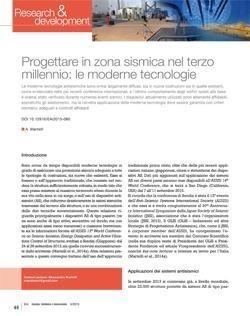Le moderne tecnologie antisismiche sono ormai largamente diffuse, sia in nuove costruzioni sia in quelle esistenti, come evidenziato nelle più recenti conferenze internazionali, e l’ottimo comportamento degli edifici isolati alla base è oramai stato verificato durante numerosi eventi sismici. I dispositivi attualmente utilizzati sono altamente affidabili, soprattutto gli elastomerici, ma la corretta applicazione delle moderne tecnologie deve essere garantita con criteri normativi adeguati e controlli affidabili
Designing in seismic areas in the third millennium: modern technologies
th World Conference on Seismic Isolation, Energy Dissipation and Active Vibrations Control of Structures, which took place in Sendai (Japan) on September 24-26, 2013. Other papers presented at this conference deal with the use of the traditional approach. More updated information on the application of the AS systems became available at the ASSISi 14th World Conference, held in San Diego (California, USA) on September 7-11, 2015.
Most SI systems rely on the use of rubber bearings (RBs), such as the High Damping natural Rubber Bearings (HDRBs), Neoprene Bearings (NBs), Lead Rubber Bearings (LRBs), or (especially in Japan) Low Damping Rubber Bearings (LDRBs) in parallel with dampers; in buildings, some plane surfaces steel-Teflon (PTFE) Sliding Devices (SDs) are frequently added to the RBs to support their light parts without unnecessarily stiffening the SI system (which would make it less effective) and (if they are significantly asymmetric in the horizontal plane) to minimize the torsion effects (the effects of the vertical asymmetries are drastically reduced by the quasi "rigid body motion" of the seismically isolated superstructure). Another type of isolators, which has been used in Italy after the 2009 Abruzzo earthquake, is the so-called Curved Surface Slider (CSS), which derived from the US Friction Pendulum (FPS) and the subsequent German Seismic Isolation Pendulum (SIP). Finally, rolling isolators (in particular Ball Bearings, BBs, and Sphere Bearings) are also applied: they are very effective and find numerous applications (more than 200 in 2013) to protect buildings in Japan, but not in Italy, because there they have been judged to be too expensive (however, they have already been used, even in Italy, to protect precious masterpieces and other contents of museums, as well as costly equipment, including that of operating-rooms in hospitals).
It shall be stressed that, to the knowledge of the author, all structures protected by RBs that were located in areas hit by even severe earthquakes so far exhibited an excellent behavior, in spite of the fact that the violence of such earthquakes was frequently underestimated


